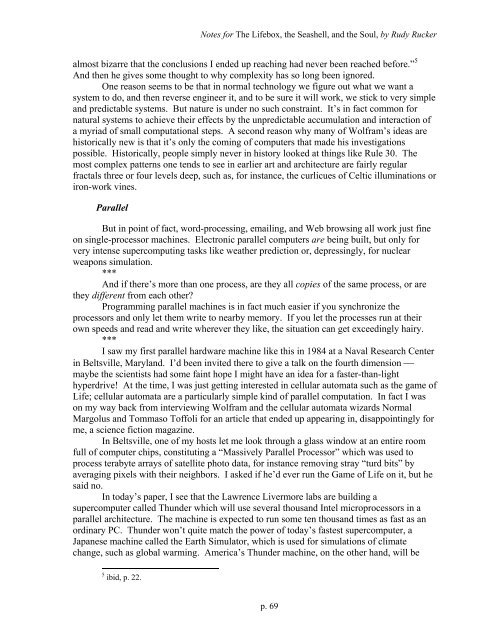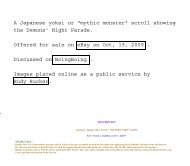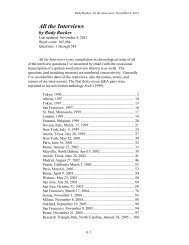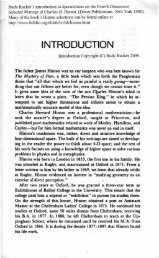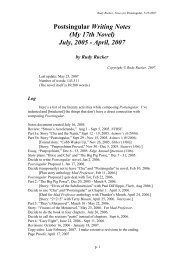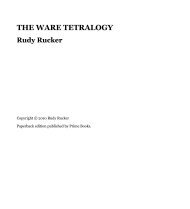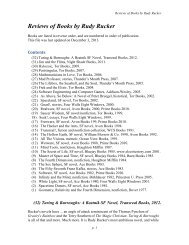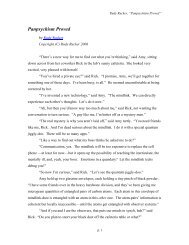Notes for the Lifebox, the Seashell, and the Soul - Rudy Rucker
Notes for the Lifebox, the Seashell, and the Soul - Rudy Rucker
Notes for the Lifebox, the Seashell, and the Soul - Rudy Rucker
You also want an ePaper? Increase the reach of your titles
YUMPU automatically turns print PDFs into web optimized ePapers that Google loves.
<strong>Notes</strong> <strong>for</strong> The <strong>Lifebox</strong>, <strong>the</strong> <strong>Seashell</strong>, <strong>and</strong> <strong>the</strong> <strong>Soul</strong>, by <strong>Rudy</strong> <strong>Rucker</strong><br />
almost bizarre that <strong>the</strong> conclusions I ended up reaching had never been reached be<strong>for</strong>e.” 5<br />
And <strong>the</strong>n he gives some thought to why complexity has so long been ignored.<br />
One reason seems to be that in normal technology we figure out what we want a<br />
system to do, <strong>and</strong> <strong>the</strong>n reverse engineer it, <strong>and</strong> to be sure it will work, we stick to very simple<br />
<strong>and</strong> predictable systems. But nature is under no such constraint. It’s in fact common <strong>for</strong><br />
natural systems to achieve <strong>the</strong>ir effects by <strong>the</strong> unpredictable accumulation <strong>and</strong> interaction of<br />
a myriad of small computational steps. A second reason why many of Wolfram’s ideas are<br />
historically new is that it’s only <strong>the</strong> coming of computers that made his investigations<br />
possible. Historically, people simply never in history looked at things like Rule 30. The<br />
most complex patterns one tends to see in earlier art <strong>and</strong> architecture are fairly regular<br />
fractals three or four levels deep, such as, <strong>for</strong> instance, <strong>the</strong> curlicues of Celtic illuminations or<br />
iron-work vines.<br />
Parallel<br />
But in point of fact, word-processing, emailing, <strong>and</strong> Web browsing all work just fine<br />
on single-processor machines. Electronic parallel computers are being built, but only <strong>for</strong><br />
very intense supercomputing tasks like wea<strong>the</strong>r prediction or, depressingly, <strong>for</strong> nuclear<br />
weapons simulation.<br />
***<br />
And if <strong>the</strong>re’s more than one process, are <strong>the</strong>y all copies of <strong>the</strong> same process, or are<br />
<strong>the</strong>y different from each o<strong>the</strong>r?<br />
Programming parallel machines is in fact much easier if you synchronize <strong>the</strong><br />
processors <strong>and</strong> only let <strong>the</strong>m write to nearby memory. If you let <strong>the</strong> processes run at <strong>the</strong>ir<br />
own speeds <strong>and</strong> read <strong>and</strong> write wherever <strong>the</strong>y like, <strong>the</strong> situation can get exceedingly hairy.<br />
***<br />
I saw my first parallel hardware machine like this in 1984 at a Naval Research Center<br />
in Beltsville, Maryl<strong>and</strong>. I’d been invited <strong>the</strong>re to give a talk on <strong>the</strong> fourth dimension ⎯<br />
maybe <strong>the</strong> scientists had some faint hope I might have an idea <strong>for</strong> a faster-than-light<br />
hyperdrive! At <strong>the</strong> time, I was just getting interested in cellular automata such as <strong>the</strong> game of<br />
Life; cellular automata are a particularly simple kind of parallel computation. In fact I was<br />
on my way back from interviewing Wolfram <strong>and</strong> <strong>the</strong> cellular automata wizards Normal<br />
Margolus <strong>and</strong> Tommaso Toffoli <strong>for</strong> an article that ended up appearing in, disappointingly <strong>for</strong><br />
me, a science fiction magazine.<br />
In Beltsville, one of my hosts let me look through a glass window at an entire room<br />
full of computer chips, constituting a “Massively Parallel Processor” which was used to<br />
process terabyte arrays of satellite photo data, <strong>for</strong> instance removing stray “turd bits” by<br />
averaging pixels with <strong>the</strong>ir neighbors. I asked if he’d ever run <strong>the</strong> Game of Life on it, but he<br />
said no.<br />
In today’s paper, I see that <strong>the</strong> Lawrence Livermore labs are building a<br />
supercomputer called Thunder which will use several thous<strong>and</strong> Intel microprocessors in a<br />
parallel architecture. The machine is expected to run some ten thous<strong>and</strong> times as fast as an<br />
ordinary PC. Thunder won’t quite match <strong>the</strong> power of today’s fastest supercomputer, a<br />
Japanese machine called <strong>the</strong> Earth Simulator, which is used <strong>for</strong> simulations of climate<br />
change, such as global warming. America’s Thunder machine, on <strong>the</strong> o<strong>the</strong>r h<strong>and</strong>, will be<br />
5 ibid, p. 22.<br />
p. 69


